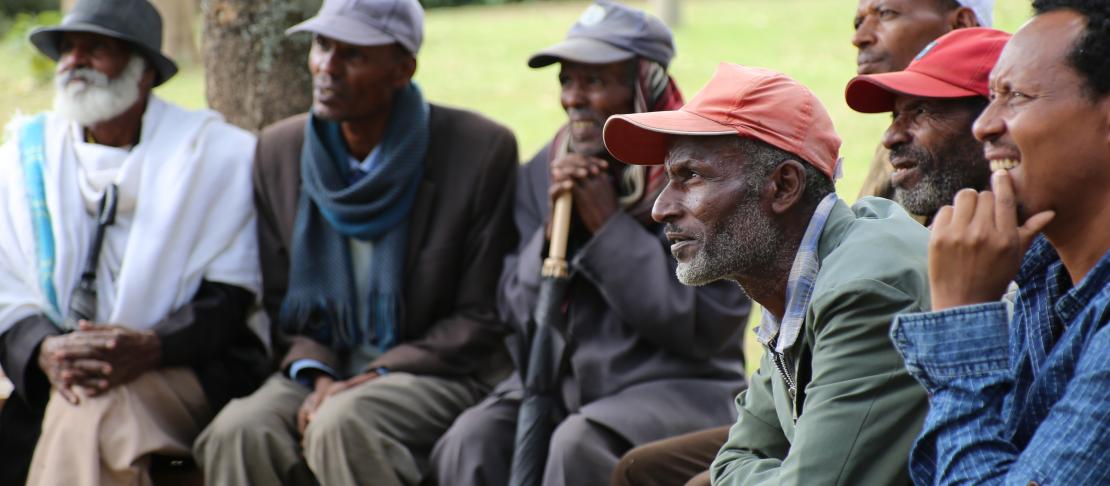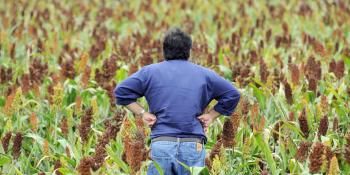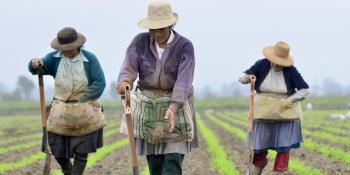Using the CCAFS Mitigation Options Tool to identify adaptation co-benefits in Ethiopia’s agriculture sector

CCAFS-MOT is a tool that provides fast, accessible, and reliable information about emissions from different agricultural practices to inform policy and management decisions in support of emission reductions in agriculture.
At a recent workshop organized by the CGIAR Research Program on Climate Change, Agriculture and Food Security (CCAFS), technical experts, educators, researchers, policy advisors, and Ethiopia’s international development partners discussed synergies between climate change mitigation and resilience- and adaptation-building efforts in agriculture. The workshop was a training on the CCAFS Mitigation Options Tool, which allows users to rapidly identify sources of greenhouse gas (GHG) emissions, rank climate change mitigation options from multiple agricultural crop and livestock management systems, and quantify adaptation co-benefits.
Supporting the implementation of Ethiopia’s Nationally Determined Contribution
Ethiopia’s NDC is one of only a few considered “2°C compatible” by the Climate Action Tracker. This rating indicates that Ethiopia’s climate action plans will bear a fair share of the global effort needed to meet the Paris Agreement. If fully implemented, Ethiopia’s NDC would lead to a 64% reduction in GHG emissions by 2030, compared to the Ethiopian business-as-usual (BAU) scenario. The majority of the abatement (about 86%) is expected to come from the agriculture, forestry and other land uses (AFOLU) sectors.
Developed by the University of Aberdeen and CCAFS, the CCAFS-MOT brings together several empirical models to estimate GHG emissions from multiple agricultural crops, crop groups (e.g. vegetables, legumes) and livestock systems using regionally-specific data.
The CCAFS-MOT can support the Ethiopian agricultural sector's contribution to the country’s NDC. It can be used to estimate GHG emissions from multiple agricultural crop and livestock management practices in different geographic regions, providing policymakers with critical information that should inform decisions on emission reductions and adaptation co-benefits from the agriculture sector. The tool identifies options and practices that reduce emissions and sequester carbon that are available for specific production systems in specific locations—essential for a country with diverse agroecological zones, land uses and farming systems such as Ethiopia. Most often, obtaining and applying this information for such diverse systems is time-consuming and requires specialized personnel.
Developed by the University of Aberdeen and CCAFS, the CCAFS-MOT brings together several empirical models to estimate GHG emissions from multiple agricultural crops, crop groups (e.g. vegetables, legumes) and livestock systems using regionally-specific data.
Real-time data and training
A week before the training, a team of 12 CGIAR and national researchers and students traveled to Lemo district, Ethiopia to collect data from Inter Aide's and USAID’s Africa Rising project site.
The data collected focused on field characteristics, farmers’ current agricultural practices, perceptions on weather changes, and socio-economic characteristics. The data was then used at a learning event on 23 March 2018 to test the Mitigation Options Tool.
Testing the tool
After the hands-on training, workshop participants highlighted the strengths of the CCAFS-MOT tool as follows:
- It ranks mitigation options for crops according to mitigation potential, factoring in current management practices, and climate and soil characteristics;
- It is an easy way to learn about GHG emissions from farming, and adaptation co-benefits including carbon sequestration potential;
- It has a low data input requirement, in an environment where data and capacity are lacking;
- It is free, making it easily accessible to resource-limited countries such as Ethiopia; and
- It runs in Excel, making it easy to use.
Some concerns were also raised by participants. Their views included the following:
- The climate and agroecological classifications do not consider the Ethiopian classification system;
- The crop types are not diverse. For example, prominent Ethiopian orphan crops such as Teff and Enset are not included;
- Information on land use change needs to be more detailed. There is a need to consider changes in tree species, and the magnitude of change including spatial and temporal dimensions and distribution;
- Emissions occurring during processing (fermentation) of particular food types, e.g. Enset, are not captured; and
- GHG emission during the decomposition process of organic fertilizers is not estimated.
From the field to policymaking
In applying the CCAFS-MOT to the diverse agriculture and land use context of Ethiopia, workshop participants discussed the quality of data needed, feasible mitigation options, modeled adaptation co-benefits and results, changes needed to contextualize the CCAFS-MOT to the Ethiopian context, barriers to implementing mitigation options, and co-benefits of mitigation options.
This CCAFS-MOT tool is very helpful for coming up with evidence-based results and conclusions in mitigation studies within the agricultural sector in Ethiopia,” said Dr. Degefie Tibebe, Director of Climate & Geospatial Research Program at the Ethiopian Institute of Agricultural Research.
Most participants considered the tool a useful starting point for providing information about GHG emissions, understanding adaptation co-benefits, and assessing mitigation options in agriculture. For the CCAFS-MOT to more specifically inform future work, participants suggested that it be updated with country-specific contextual data. This includes incorporation of a geospatial platform, especially if the intention is beyond stimulating scientific discussion and for actual planning decisions at scale. A community of practice is being established to develop the CCAFS-MOT to include more specific characteristics of the Ethiopian agricultural and land use sectors.
Read more:
- Presentations: CCAFS EA Presentation for MOT training at ILRI Addis Ababa, Ethiopia
- Photos: CCAFS Mitigation Options Tool (MOT) workshop
- CIAT blog: CIAT and CCAFS launch Ethiopia Climate-Smart Agriculture Country Profile
The CCAFS East Africa Regional Program, CCAFS Low Emissions Development Flagship, the University of Aberdeen, and the United States Department of Agriculture (USDA) Foreign Agricultural Service (FAS) organized the workshop in collaboration with the International Center for Tropical Agriculture (CIAT) and the Ethiopian Institute for Agricultural Research (EIAR), with generous financial support from CCAFS, the United States Department of State, and USDA-FAS. The International Livestock Research Institute (ILRI) in Addis Ababa, Ethiopia hosted the workshop.
Over 50 technical experts, educators, researchers and policy advisors from the following institutions attended: Ethiopian Agriculture Transformation Agency (ATA), Ministry of Agriculture and Natural Resources (MoANR); Ministry of Environment Forestry and Climate Change (MEFCC); Federal Government and Regional State institutions for higher learning and research; CGIAR centers including CIAT, the International Crops Research Institute for the Semi-Arid Tropics (ICRISAT), the International Maize and Wheat Improvement Centre (CIMMYT) and the International Water Management Institute (IWMI); and NGOs including GIZ and Digital Green.
Catherine Mungai is the Partnerships and Policy Specialist at CCAFS East Africa. John Recha is the Participatory Action Research (PAR) Specialist at CCAFS East Africa. Dawit Solomon is the Regional Program Leader at CCAFS East Africa. Diana Feliciano is a Research Fellow at the University of Aberdeen.


